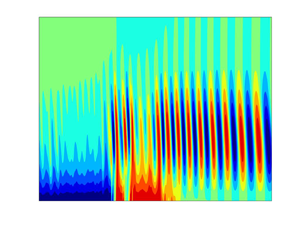Article contents
An adjoint approach for computing the receptivity of the rotating disc boundary layer to surface roughness
Published online by Cambridge University Press: 06 September 2021
Abstract

An adjoint approach is developed to compute the receptivity of the rotating disc boundary layer to surface roughness. The adjoint linearised Navier–Stokes equations, in cylindrical coordinates, are derived and receptivity characteristics are computed for a broad range of azimuthal mode numbers using a fully equivalent velocity–vorticity formulation. For each set of flow conditions (i.e. azimuthal mode number), the adjoint method only requires that the linear and adjoint solutions be computed once. Thus, the adjoint approach offers significant computational and time advantages over alternative receptivity schemes (i.e. direct linearised Navier–Stokes) as they can be used to instantaneously compute the receptivity of boundary layer disturbances to many environmental mechanisms. Stationary cross-flow disturbances are established by randomly distributed surface roughness that is periodic in the azimuthal direction and modelled via a linearisation of the no-slip condition on the disc surface. Each roughness distribution is scaled on its respective root-mean-square. A Monte-Carlo type uncertainty quantification analysis is performed, whereby mean receptivity amplitudes are computed by averaging over many thousands of roughness realisations with variable length and wavelength filters. The amplitude of the cross-flow instability is significantly larger for roughness distributions near the conditions for neutral linear instability, while roughness elements radially outboard have a negligible effect on the receptivity process. Furthermore, receptivity increases sharply for roughness distributions that encompass wavelength scales equivalent to that associated with the cross-flow instability. Finally, mean receptivity characteristics are used to predict the radial range that stationary cross-flow vortices achieve amplitudes sufficient to invalidate the linear stability assumptions.
- Type
- JFM Papers
- Information
- Copyright
- © The Author(s), 2021. Published by Cambridge University Press
References
REFERENCES
- 7
- Cited by



